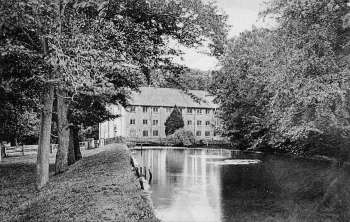 |
|
c.1907
|
|
Aylsham Mill
River Bure |
 |
|
c.1907
|
|
Aylsham watermill was rebuilt to a Georgian design, entirely of brick with a pantile roof in 1798 as shown on a stone plaque above one of its waterways. A stone in the gable of one of the old maltings refers to the date of 1771 and the builder, Robert Parmeter, who was possibly anticipating the 1773 Act of Parliament that authorised the construction of the Aylsham_Navigation. The mill was sometimes known as Millgate Mill as it lies just off the road of that name that lead from the town down to the river on the north side of Aylsham. A mill has almost certainly been on the site since Domesday or before. Unusually, the mill had three lucums, two over land and one over the millpool to make use of the wherries. |
November 4th |
As an Opinion has lately prevailed that the MILLERS have always refused to grind Corn for the Poor or other Persons in small Quantities or if they did, that Abuses were made use of to damage the same; To remove such Prejudices for the future, we whose Names are hereunder subscribed, residing in the several Parishes mentioned with our Names, have engaged for the Time to come or until the Prices of Corn shall be very considerably reduced, to grind (at Threepence per Bushel) Corn in small Quantities for the Poor and other Persons in the speediest, best and most proper Manner and deliver the same without and Adulteration. |
John Withers, Northwalsham Robert Colls, Worstead Wm. Pepper & Co. Buxton Robert Parmeter, Aylsham |
N.B. MEAL will be sold by us in small Quantities as cheap as the Prices of Corn, which we shall be oblig'd to give, will possibly admit of. Norwich Mercury - 15th November 1766 |
| N.B. The average price of wheat in 1766 was £2. 3s. 1d. per quarter. |
Royal Exchange Fire Insurance policy 89532 |
Robt. Parmeter of Aylsham in the County of Norfolk, Miller. On his Water Millhouse & Granaries adjoining brick, timber & stud built & tiled & on the Mills in the said Millhouse together with the Running Tackle & other parts of the Machinery Belonging thereto situate in Aylsham aforesaid - £700. Utensils & Stock in Trade therein - £750. On his Dwelling House, Backhouse & Brewhouse adjoining & having communication brick built & tiled situate the corner of the Turning leading to the said mIll - £450. On Furniture therein - £160. On Wearing Apparel in the same - £70. Library of Books in the same - £10. Plate in the same - £10. On a House near the said mIll, Tent. Wm. Cook - £100. On a House adjoining Tent. Rob. Earle - £50. On a Building being Stables belonging - £50. House & Stable adjoining situate in Aylsham aforesd. Tenant Benj. Savory, a Baker - £200. The above are brick built & tiled. (Returned 18/9 for 6 months and Days on No. 53772). 25th May 1784 |
Royal Exchange Fire Insurance policy 135171 |
Robt. Parmeter of Aylsham in the County of Norfolk, Miller. On a Water Millhouse & Granaries adjoing. Brick, Timber, Stud & Tiled & on the Mills, Geers & Machinery therein Situate in Aylsham aforesd. - £700. On Utensils & Trade therein - £750. On a House Brick & Tiled Tenant Mrs. Parmeter, nr. £150. On a House adjoing. Brick built Tent. Cook, nr. - £100. On a House adjoing. Brick built Tent. Earle, nr. - £50. On a Range of Stables belongg. brick & Tiled nr. - £50. On his Dwellg. House, Back House & Brewhouse adjoining Brick & Tiled situate at the Corner of the turning leading to the said Mill & having Communication therewith - £450. On Furniture therein - £160. On Printed Books in the fame - £10. On his Malt House Brick & Tiled Situate Opposite his Dwelling House aforesd. - £450. On Utensils & Trade therein - £850. On a Stable Brick & tiled adjoing. the last mentioned - £50. All fituate in Aylsham aforesd. On a House Brick & Tiled - £50. On a Water Mill House adjoing. the last mentioned & having Communication therewith & on the Mills, Geers & Machinery therein Brick, Timber & tiled - £200. On Utensils & trade therein - £300. On a Stable & Granary above the fame adjoining the said Dwelling House, Brick & Tiled - £50. On Utensils & Trade therein - £100. On a Granary & Shed adjoing. forming a Pafsage to sd. Granary Brick & Tiled (except the Pafsage) which is stud - £200. On Utensils & Trade therein - £500. All fituate in Ingworth in the County aforesaid. (Renewed from No. 89532 Renewed from No. 97883). 21st August 1793 |
Royal Exchange Fire Insurance policy 154677 |
Robt. Parmeter & Peter Dent of Aylsham in the Co. of Norfolk, Millers. On a Water Corn Mill Brick, Timber, Stud & tiled - £900. On the Water Wheels &c. - £400. On Stock in Trade inclg. &c. in the said Mill and in the Granary adjg. & commg. - £500. On the said Granary Brick, Timber & tiled - £100. On a Malthouse & Granary adjg. Brick, Timber & tiled nr. - £450. On Utensils & Trade therein - £1,000. On a House Brick & tiled Tent. Mrs. Parmeter - £150. On a House Brick & tiled Tent. Saml. Turner - £50. On a House Brick & tiled Tent. Robt. Earl - £30. On a Range of Stable Brick & tiled near in their own occupation - £50. On a House and Offices adjg. Brick & tiled Tent. the faid Robt. Parmeter - £350. On Furniture therein - £250. On Apparel in the fame - £70. All sit. in Alysham afsd. The Whole of the above is the Sole Property of the sd. Robt. Parmeter excepting the fecond, third and Sixth Articles which are in Partnership. Warranted that there be no Steam Engine or Kiln in, adjg. to, or commg with any of the above Buildgs. (Renewed from 135171). 24th December 1796 |
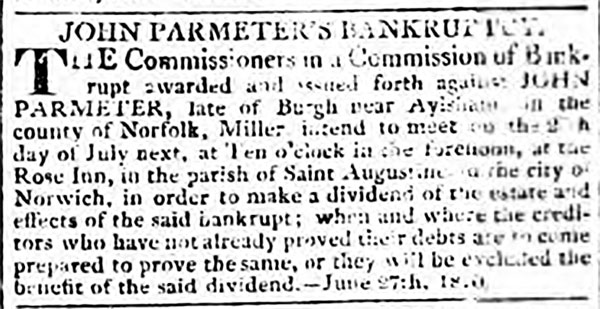 |
|
Norfolk Chronicle - 11th August 1810
|
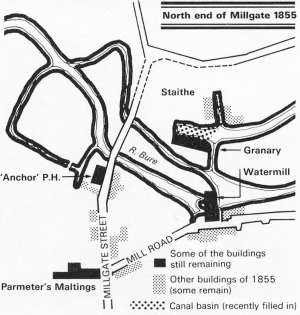 |
|
1855 layout of the staithe |
 |
|
Aylsham
staithe 1928
|
|
In
1770 the miller Thomas Spurrell died and left a will in the Norwich Consistory
Court. He describes the mills as "...all those water mills called Aylsham mills..."
and he was obviously very well-off. Of particular interest concerning
the mills was the appointment of his executors, one of whom was Thomas
Harvey of Aylsham, Millwright while another was Joseph Ames of the mills
in Hellesdon, Gentleman.
The latter appointment implies considerable contact between Spurrell and
Ames even though Hellesdon is not on the
Aylsham Navigation although Oxnead is and Joseph
Ames ran that mill at some point, certainly in 1779. The will was signed
26 March 1770 and Thomas Spurrell was buried in Aylsham 23 June 1770,
these dates are consistent with Robert Parmeter taking over the mill in
1771. |
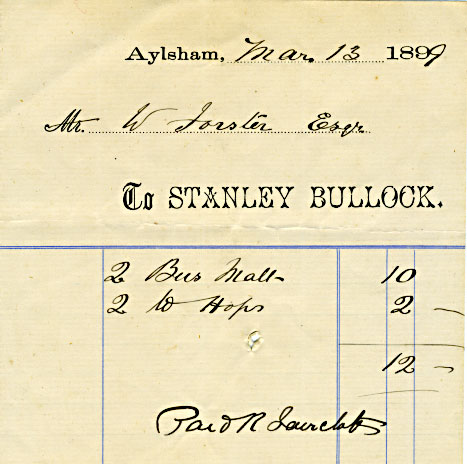
|
At some time in the second half of the 19th century, the block that runs along the south edge of the millpool was built, in two phases, replacing an older detached building. The millpool was also widened right up to its walls. This part of the premises was described in the 1914 sale catalogue as 'extensive granaries, with large Coal Store below and two Wheat Floors above, convenient for loading or unloading from the river or road'. |
Over the centuries
the whole area was moulded and developed with Millgate becoming a hub of
industrial activity once the 11 mile long Aylsham_Navigation was opened on completion of the new canal basin excavated
alongside the mill in October 1779. A channel was cut to the north of the
mill and a staithe with warehousing was built to house the goods transported
in and out by wherry. By 1854 wherries plied weekly between Aylsham and
Yarmouth. At the height of the water transport years 26 wherries were serving
Aylsham. In 1880 the railway arrived. Aylsham North's M&GN station a few hundred yards away took over some of the traffic when it opened, as did the GER's Aylsham South station. Nearby pubs and inns such as The Anchor thrived for many generations. |
|
The Aylsham Navigation |
|
| 1773: Navigation
authorised by an Act of Parliament 1774: Work started 1779: Navigation opened, running for 9½ miles with 5 locks, one at each of the mills
26th August 1912: The great flood effectively closed the Naviagation by destroying the locks 1974: Aylsham Canal Basin filled in |
 |
|
Aylsham
lock 1928
|
The disastrous
flood of August 1912 destroyed many of the locks of the Aylsham_Navigation. These were never repaired as the commissioners had insufficient
funds. Traffic to Aylsham was thus reduced to road and rail only. The wherry
Zulu was on its way back from Aylsham to the coast when it was caught by
the flood. After the destruction of the lock gates the Zulu had to be carried
over the road at Buxton. |
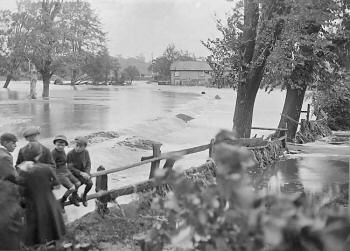 |
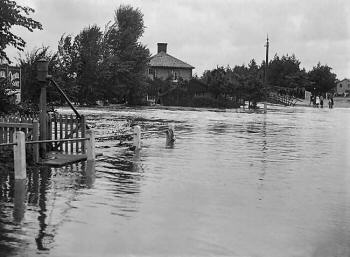 |
Millgate looking northwest August 1912 |
Millgate looking north August 1912 |
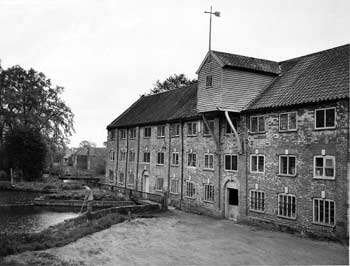 |
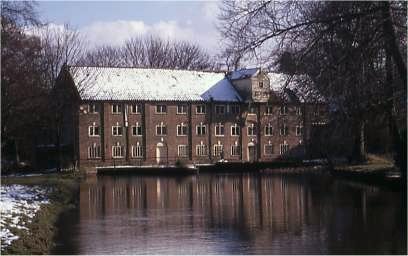 |
c.1950 |
March 1970 |
By 1864 the
watermill had a competitor - a new steam_mill built on the other side
of the canal only a hundred yards away at the industrial hamlet of Dunkirk.
These mills both worked independently for half a century until Barclay,
Pallett and Co., having acquired the steam mill in 1907, bought the watermill
in 1914 at the auction described on the link above. At this time the watermill had two water wheels and the power they produced was used to turn five pairs of stones. However, the smaller wheel was removed in the mid 1950s and the remaining wheel then powered two meal-mixing machines, while several electrically driven high-speed hammer mills did the work of milling animal foodstuffs. |
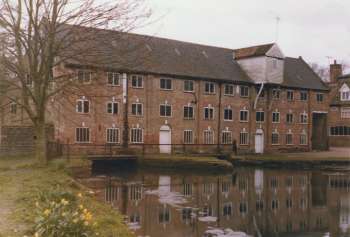 |
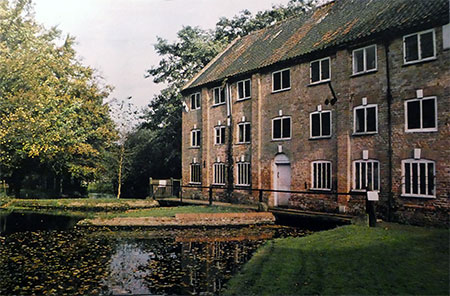 |
|
7th
April 1977
|
c.1980 |
Around 1960
a toe bearing on an upright shaft broke and was replaced with a ball and
thrust bearing made by SKF. A pit wheel was recogged using beech, apple
and hornbeam. Unfortunately, after only running for a short time, a wedge
holding the upright shaft shifted causing the shaft to move out of line,
this resulted in many of the cogs breaking off. They were never replaced
- see pictures on the machinery link below. |
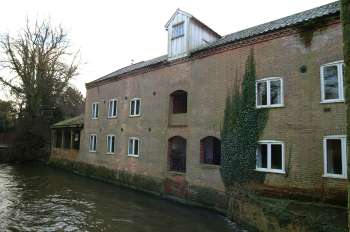 |
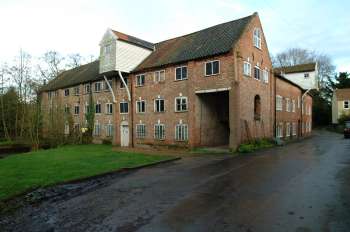 |
|
Millpool lucum 6th January 2003
|
The two road transport lucums November 2002 |
|
Barclay &
Pallet was acquired by BOCM (British Oil & Cake Mills) in 1967.
Aylsham mill was vacated in the same year, and a new provender mill
(preparing animal feedstuffs) was built to replace the steam mills at
Dunkirk. Thus, although the methods changed, the long history of corn
milling on the banks of the Bure at Aylsham continued unbroken for perhaps
a thousand years. |
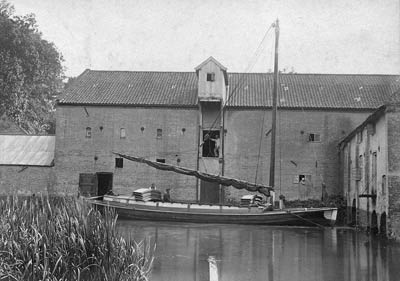 |
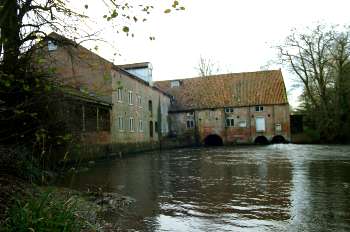 |
|
The wherry Palmerston unloading 1902
|
24th November 2002 |
In 1759 an
Aylsham mason William Berry, built the single arch brick bridge over the
Bure just above the mill that is still in use today, replacing the old
wooden structure. Miraculously the bridge survived the 1912 flood as the
river above it overflowed into the staithe. |
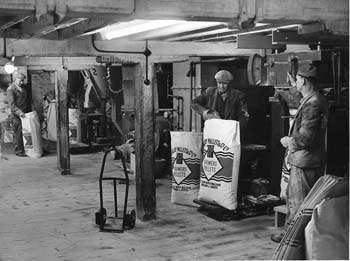 |
|
New
pelleting machinery in 1954
|
|
New pelleting machinery was installed by Simon Barron in 1954 and is seen being operated by Harry Ashton, Billy Pooley and Jack Pegg. |
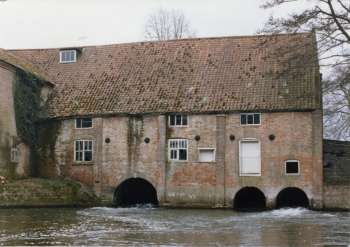 |
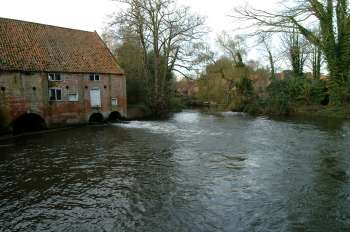 |
|||
|
Tailrace 7th April 1977
|
The cut leading to the staithe November 2002
|
|||
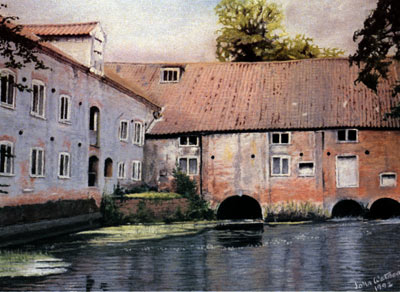 |
Watercolour by John Watson 1992 |
Nothing
run of the
mill about
this gem
|
It is a fine Georgian watermill, a vital
part of a north Norfolk town’s
heritage - but its condition has
taken a turn for the worse in recent years. In the final part of
our Norfolk Heritage at Risk series,
KEIRON PIM looks at Aylsham Mill, subject of a longstanding wrangle
between developers and residents. “AYLSHAM IS SUPPOSED TO BE THE JEWEL IN THE CROWN OF BROADLAND, and the Mill is supposed to be the jewel in the crown of Aylsham - but at the moment it’s a very badly tarnished jewel.” So says David Harrison, who sits on Aylsham town council and on Norfolk County Council. The Georgian watermill was at the heart of Aylsham’s economy in the 19th century: wherries would sail up the Bure to the mill to deposit goods for the townspeople and would collect flour to transport by water to Yarmouth. Its grounds also served as an amenity for local people to walk their dogs, feed the ducks, launch canoes, hold Brownie pack meetings or school art classes - and this lies at the heart of the conflict now surrounding the mill. It stands in one of the market town’s most picturesque corners, where the river is flanked by weeping willows on one side and green space frequented by ducks and geese on the other. While the setting remains beautiful, the mill itself has been allowed to slip into a tatty condition and in the past few years its future has been up in the air owing to a dispute between would-be developers and the town’s residents. Lying discarded just inside the building is a faded “for sale” notice advertising luxury apartments. In front of the watermill, just off Mill Row, lies a 30m-square patch of what was effectively a village green but is now overgrown and ridden with weeds. It is only viewable through a metal fence that has been erected by the developers, barring public access to what many residents believe to be common land; in 2005 a 700-name petition argued for it to be officially registered as such. “The problem is that the owners have said ‘If we develop the ground floor that overlooks the green space, who would want to look out of the window if people keep walking past the front door?’,” says Geoff Gale, chairman of the Aylsham Local History Society. Since the town council stepped in to try to secure “village green” status, the proposed development has ground to a halt but now an urgent works notice is being considered, meaning that the developers would have an ultimatum. Mr Harrison said: “The district council has quite draconian powers if they want to use them. At the moment it’s a standoff. The point was that by doing that [erecting the fence] the owners brought the ownership of the land into the public domain. They claimed that they own the land, when there’s no evidence that they do. They have got a few months to get on with repairs. The roof is in a bad situation and if they don’t, the enforcement action will go ahead, I imagine.” These problems have led to the mill being placed on Norfolk County Council’s Buildings at Risk Register. The grade II listed mill is ranked as a Category B, which means: “Immediate risk of further rapid deterioration or loss of fabric; solution agreed but not yet implemented”. The plans are for several new flats, adding to an existing set of flats already inhabited at the back of the building. The new proposals have been submitted by Taverham-based Jonathan and Martine Spalding, who declined to comment when approached by the EDP. Mr and Mrs Spalding own the mill through two companies - a dormant company called Aylsham Mill Residents Association and DJLM Developments, a property development business that they formed with another couple, who dropped out of the partnership in May of this year. In June 2005 the EDP reported on new attempts to broker a deal and at the time a spokesman for DJLM said: “The village green would stop construction because of the effect on the rights of way. We would not renovate the building and invest a substantial amount of money in this grade II listed building.” The Spaldings are due for a meeting with Broadland District Council this week as the council bids once again to get things moving. Phil Courtier, the council’s head of development and conservation, said on Monday: “Broadland District Council is very keen to continue to work with the owners. We have a meeting scheduled for later in this week to try to get on with resolving this issue and move towards the aim of restoring the mill to its former glory.” If and when that day arrives it will please plenty of people in Aylsham and others further afield with a passion for Norfolk’s historic mills. Jonathan Neville, who lives in the nearby village of Itteringham, runs the Norfolk Mills website, which documents the history of every wind and watermill in the county. He said: “Architecturally it’s a very nice building. The section that is over the river still has some of the machinery in it.” Mr Neville’s website includes an old interview, conducted by Aylsham historians Lynette Rust and Ron Peabody, with Cyril “Sam” Spinks, who was born in 1890 and worked at the mill for 55 years. When asked what the wherries would bring to the mill, he recalled they could carry: “Fifteen tons - anything, coal, kale, cake, corn, maize, anything of that sort, and bring groceries up here for the shops up town. Onions, great boxes of onions - all sorts.” There has been a mill on the site since the Domesday Book, but the present building was constructed in 1798 under the ownership of Robert Parmeter. Mr. Neville’s website states that in 1804 Arthur Young, an author on agricultural topics, described Parmeter as “a considerable farmer also, and a very intelligent, sensible man”. By 1836 Parmeter’s son, Samuel, had taken over the business, also running a weekly wherry service to Norwich. The 1851 census mentions Samuel Parmeter, 51, a miller, corn merchant and maltster, of Millgate, Aylsham. He was accompanied by seven journeyman millers, a journeyman millwright and a master miller and baker. By 1854 Samuel was in partnership with a Mr Bullock and by 1864 the mill was owned by the Bullock Bros. It stayed in that family until 1914 when Stanley Bullock died and the mill was sold at auction to Barclay & Pallett Ltd. The auction catalogue described: “An admirably situated water corn mill, with mill dam and mill pool (excluding boat house and site), flood gates and sluices, and conveniently situated on the River Bure, nearly adjoining the Midland & Great Northern Railway Station, and within one mile of the Great Eastern Railway Station. The Mill is substantially built with four floors, and worked by two water wheels... There are 19 large and small wheat bins, also flour room and counting house. There is a good supply of water and, except in very dry weather, the mill can be kept going night and day.” By 1937 Barclay & Pallett were also listed in Kelly’s Directory as coal, coke, corn, flour and seed merchants. Mr. Pallett’s grandson, Ben Rust, became the last miller. He lived in the millhouse as a child and still lives in Aylsham, now aged 87. “I remember it as a very happy place,” he said. “I remember that the road was private and belonged to the householders on either side, but people could come and go to the river. There was a footpath to the staithe. As long as people behaved themselves they were allowed to have access to the river, and of course that is the issue at stake now. “I’m afraid that the developers seem to have upset everybody and it’s a sad story. There is no reason at all why it shouldn’t work as it did before. People used to come down to walk their dogs or sit and do some sketching. That was the case up until the late 1960s, when we sold it. We sold to British Oil and Cake Mill, which was Unilever.” Jim and Barbara Crampton bought Aylsham Mill in 1969 at an auction at Norwich’s Royal Hotel. “It was kept up by the Cramptons,” says Mr Rust. “They did the development to the rear of the building, putting in the flats. During their ownership there was subsidence and the whole thing was piled, they had around 180 piles put in.” Since the sale to the present owners little appears to have happened. Will this be the year that its future becomes resolved and it moves back towards being a living building? Mr Rust certainly hopes so. “Something has to be done, there is no other option. It can’t stay as it is. There’s no reason why a solution can’t be found.” |
| Keiron Pim - Eastern Daily Press - 9th July 2008 |
Statement from Mr. & Mrs. Spalding - owners of Aylsham watermill |
Further to the Eastern Daily Press newspaper article of 9th July 2008, we feel we need to set the record straight. |
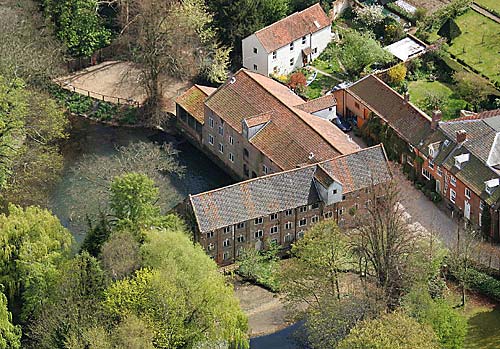 |
18th April 2007 |
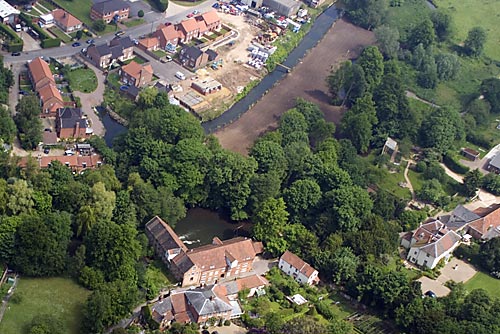 |
31st May 2008 |
A relative of mine was Joseph Hallmark Thirkettle, born 1838 I believe in Hempnall. I have him living in Millgate, Aylsham. and in the 1871, 1881, 1891, 1901 census he is a miller or miller's foreman. In the 1911 census he was living
Millgate and described as a Miller in a Flour Mill aged about 73, he died in 1916. He is my 3 x grandfather, whose daughter, Fanny Hester Thirkettle married into the Wilkin's from Aldborough. |
|
It was as a young apprentice millwright age 16 that I first set foot inside a water mill which was based in Aylsham. It was owned by Barclay and Pallett and my firm F. Flowerdew & Son of Norwich had been called in to repair some of the machinery. I can still recall hearing the slap, slap of the water hitting the paddles oif the water wheel as it turned, the rumble of the gear wheels and the swising noise of the stones at work. |
Aylsham Town Council applied to have land adjacent to the mill regisaterd as a Village Green. A hearing was held in November 2009 and the application was rejected on legal grounds. Such matters as disruption and nuisance to residents and health and safety of the public beside a deep, fast flowing river running under a mill were deemed legally irrelevant. Use this link to download a full copy of the Hearing Report. |
Long-running Aylsham Watermill land dispute
to continue A nine-year row over a the use of a green area in front of a former town mill looks set to continue after a planning decision was deferred for six months. |
Earlier this year Aylsham Town Council put in an application to Broadland District Council for planning permission to change the use of the land at Mill Row, near Aylsham Watermill, for recreational activities. |
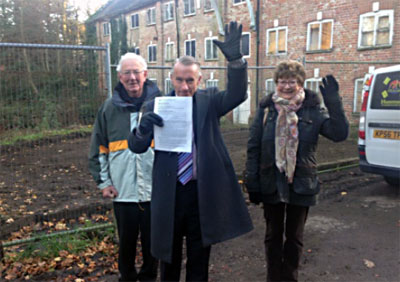 |
Aylsham Town Councillors - Barry Lancaster, David Harrison and Annette Overton.- December 2014 |
“It has been 10 long years” - Decision made over land outside historic Aylsham
watermill
|
Community leaders are celebrating a planning victory after calling for riverside land outside a historic mill to be made available for public use. |
Aylsham Town Council had applied for permission to make the disputed land, outside the building on Mill Row, available for recreational use. Broadland District Council refused the application, but the town council appealed to the Planning Inspectorate, which overturned Broadland’s decision this week. But mill owner John Spalding said he was disappointed with the news, and claimed the town council had wasted taxpayers’ money in fighting the decision. He said it was a shame that a listed building was sitting next to the land but, as a result of the decision, he would now be unable to do anything with it. Mr Spalding, who bought the building 10 years ago, had planned to build a car park on the 0.2 hectare area for the mill, which has been partially converted into flats. After hearing the news, David Harrison, Norfolk County Council deputy leader and Aylsham town councillor, said he was elated that a river he had played at as a child could be open for others to enjoy. “It has been 10 long years,” he said. “I remember walking down there with my dog to feed the swans. It had been used since I was a child.” Planning inspector David Spencer reported that evidence persuaded him the town council was committed to delivering an informal open site. He said: “The site would also provide a rare opportunity for people to safely view the River Bure in Aylsham.” He recognised that this planning consent would enable “delivery mechanisms” such as a Compulsory Purchase Order to be progressed. A previous bid to get the site designated a village green failed at an inquiry in 2009, because of a technicality over the length of proven public usage. Annette Overton, vicechairman of the town council, said the outcome of the appeal was a good decision for the local community. Mr Harrison added that it was one step on the road to acquiring a Compulsory Purchase Order for the land, which has been at the centre of longrunning ownership disputes. Sabah Meddings, Eastern Daily Press - Thursday 11th December 2014 |
Compromise agreed over long-running
Aylsham Water Mill saga |
A long-running dispute ovber the use of land next to Aylsham Water Mill could soon be over after a compromise was reached. |
The final home for sale in a converted Norfolk watermill once earmarked for demolition
|
It began as pension project but 14 years later, the renovation of Aylsham's watermill is finally complete and the third and last property is up for sale. Property editor Caroline Culot went to take a look at Wagtail, for sale for a guide price of £625,000. |
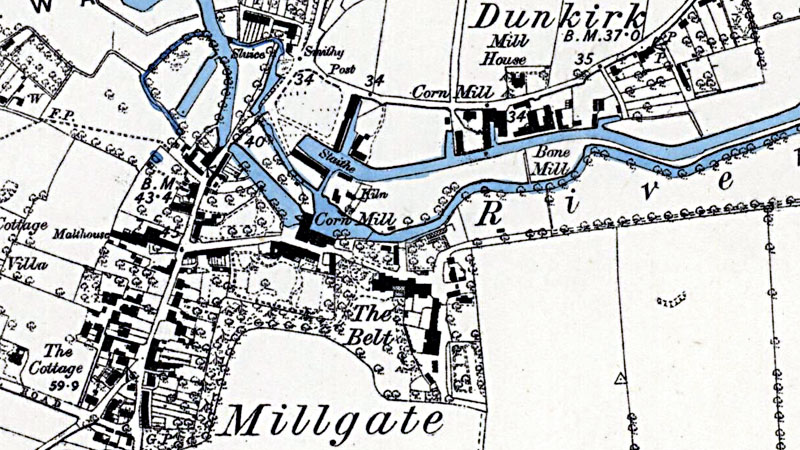 |
O.S. Map 1885 Courtesy of NLS map images |
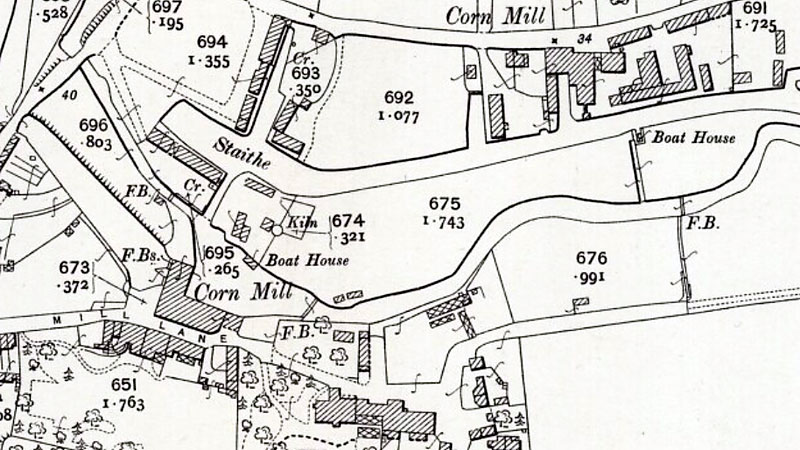 |
O.S. Map 1905 Courtesy of NLS map images |
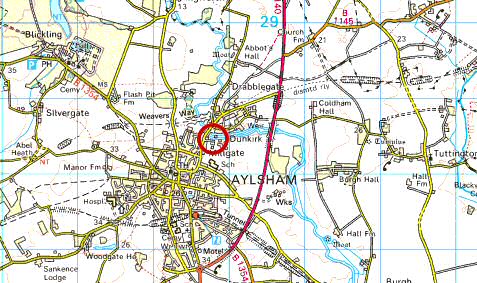 |
O.S. Map 2005 Image reproduced under licence from Ordnance Survey |
|
Domesday
1086: First written record of the mill
By 1854 Samuel
Parmeter was in partnership with a gentleman called Bullock
Kelly's 1883: Bullock Bros., millers 25th July
1969: Aylsham Mill was auctioned by J. R. E. Draper & Co at the Royal
Hotel in Norwich.
2002: Much
of the machinery still remaining |
If
you have any memories, anecdotes or photos please let us know and we may
be able to use them to update the site. By all means telephone 07836 675369
or
|
| Nat Grid Ref TG 19792745 | Copyright © Jonathan Neville 2003 |